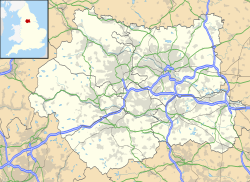| Pontefract Market Hall | |
|---|---|
 Pontefract Market Hall | |
| General information | |
| Classification | |
Listed Building – Grade II | |
| Designated | 29 July 1950 |
| Reference no. | 1313248 |
| Town or city | Pontefract |
| Country | England |
| Coordinates | 53°41′31″N1°18′39″W / 53.6920°N 1.3108°W |
| Construction started | 1859 |
| Completed | 1860 |
| Design and construction | |
| Architect(s) | Joseph Wilson |
Pontefract Market Hall is a market hall in Pontefract, West Yorkshire, England. It was completed in 1860. Pontefract market takes place both in the hall and on the Market Place on which the hall is situated. It was designated a Grade II listed building in 1950. [1]

